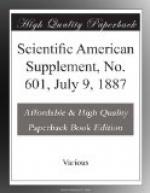* * * * *
THE NEW BRITISH COINAGE AND JUBILEE MEDAL.
An important addition will be made to the coins now in circulation by the issue of the double florin, the design of which is shown in one of our engravings. The reverse is composed of crowned shields, bearing the arms of the United Kingdom arranged in the form of a cross between scepters, a device which was first adopted for coins of Charles II. It was designed by Thomas Simon, the greatest of all English engravers, and it remains to be seen whether this handsome coin will be generally popular. The reverse of the florin will for the future bear the same design.
During the past year her majesty was pleased to signify her pleasure that a portrait medallion, by Mr. J.E. Boehm, R.A., modeled from life, should be substituted for the effigy which the coins have hitherto borne. In the new effigy, her majesty appears crowned and veiled, with the ribbon and star of the garter and the Victoria and Albert order. The legend “Victoria Dei Gratia Britanniarum Regina, Fidei Defensor” is variously arranged on the different coins, according to the exigencies of the design.
The opportunity has at the same time been taken, with her majesty’s approval, for making certain alterations in the designs for the reverses of some of the coins by abandoning those which did not appear to possess sufficient artistic merit to warrant their retention. The reverse of the sovereign will still bear the design of St. George and the Dragon, by Pistrucci, first adopted for the sovereigns of George IV., and the reverses of the half-sovereign and threepence remain unchanged, except that the crown has been assimilated to that used for the new effigy. The St. George and the Dragon design will be resumed for the five-pound piece, the double sovereign, and the crown, this design having been adopted for these pieces when originally struck. The half-crown will bear the same reverse as that coin bore when first issued, a design of considerable merit, by Merlin. During the last half century public taste appears to have been satisfied, both in this country and abroad, with some such insignificant design as a wreath surrounding words or figures indicating the value of the coin; and the shilling and sixpence have, during the present reign, been examples of this treatment. They will in future, like the half-crown, bear the royal arms, crowned, and surrounded by the garter.
The queen was further pleased to command that the fiftieth anniversary of her majesty’s accession should be commemorated by the issue of a medal. The effigy for this medal, which is also from a medallion by Mr. Boehm, has a somewhat more ornate veil than that on the coin; and on the bust, in addition to the Victoria and Albert order, is shown the badge of the imperial order of the crown of India. The reverse is a beautiful work by Sir Frederic Leighton,




